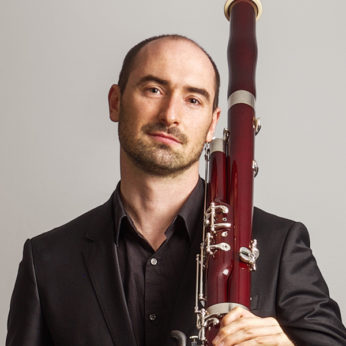Composer: Antonio Vivaldi (b. 1678 - d. 1741)
Performance date: 29/06/2015
Venue: St. Brendan’s Church
Composition Year: 1730
Duration: 00:10:40
Recording Engineer: Richard McCullough, RTÉ lyric fm
Instrumentation Category:Small Mixed Ensemble
Instrumentation Other: bsn (2vn,va,vc, db, lute, hpd)
Artists:
Arcangelo (Sophie Gent, James Toll [violins], Rebecca Jones [viola], Sarah McMahon [cello], Tim Amherst [bass], David Miller [lute], Jonathan Cohen [harpsichord,director]) -
[baroque ensemble]
Peter Whelan -
[bassoon]

In
the 1920s, a remarkable collection of Vivaldi manuscripts, officially entitled
the Foà-Giordano Collection but known generally as the Turin Manuscripts, was
discovered in Italy containing several hundred works. Most of the works represented
in the collection are in the composer’s own hand and were previously unknown to
both scholars and performers. Among the most astonishing discoveries was a set
of thirty-nine concerti for solo bassoon, strings, and continuo – thirty-seven
complete works and two fragments. These works represent more than ten percent
of all of Vivaldi’s solo concerti and rank second only to his violin concerti
in number. Considering
the small number of solo concertos for the bassoon from the baroque or any
other period the sheer quantity of Vivaldi’s compositions for this instrument
is remarkable.
Vivaldi wrote thirteen bassoon concerti in C
major. The quicker outer movements are in ritornello
form, reappearances of the opening tutti
material is separated by episodes in which the soloist is featured. The opening
tutti of RV 472 is unusual in that it
presents two different motives and in the following tutti a third motive is introduced. The interrupting tutti are usually incomplete and in
other closely related keys while solo part is mostly completely unrelated. The
slow movement is reminiscent of an aria with a scene-setting opening, a theme
that will later return as a coda. The final movement contains only three
episodes displaying the prowess of the soloist accompanied by the continuo
instruments. Fragments of the tutti
material is heard in this accompaniment but elsewhere the relationship between
the tutti and episodes is no more
than vestigial. Except for some mischief, the technical demands of RV 472 are
much more humane than the composers other concerti and overall it is extremely
melodic.
Copyright © 2025 West Cork Music. All rights reserved.
Designed and developed by Matrix Internet